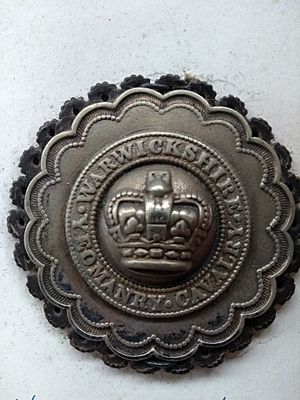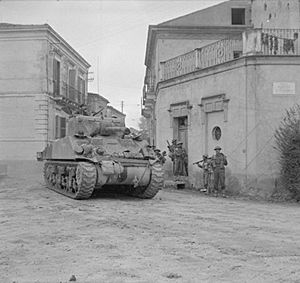Warwickshire Yeomanry facts for kids
Quick facts for kids Warwickshire Yeomanry |
|
|---|---|

Harness badge of the Warwickshire Yeomanry, c1880
|
|
| Active | 1794–Present |
| Country | |
| Branch | |
| Type | Yeomanry |
| Size | Regiment |
| Part of | 1st South Midland Mounted Brigade (First World War) Royal Armoured Corps (Second World War) |
| Engagements | Second Boer War First World War |
| Battle honours | See battle honours below |
The Warwickshire Yeomanry was a special volunteer army group in the United Kingdom. It started in 1794. This group served as soldiers on horseback, called cavalry. Later, they became machine gunners and even used tanks.
They fought in the First World War and the Second World War. In 1956, they joined with another group to form the Queen's Own Warwickshire and Worcestershire Yeomanry. Today, a part of the Royal Yeomanry continues their history.
History of the Warwickshire Yeomanry
How the Regiment Started
The Warwickshire Yeomanry began in 1794. It was first called the Gentlemen and Yeomanry of Warwickshire. These were volunteer soldiers who rode horses. They formed four small groups, known as troops.
By 1796, these troops officially became the Warwickshire Regiment of Yeomanry Cavalry. More troops were added over the years. By 1854, during the Crimean War, they had eight troops.
Fighting in the Second Boer War
The Yeomanry was usually meant for defending the home country. But in 1899, the British government needed more soldiers overseas. This was during the Second Boer War in South Africa.
So, the Yeomanry was asked to send volunteer companies. Each company had about 115 men. The Warwickshire Yeomanry sent two companies to fight in South Africa.
In 1901, the group changed. They became mounted infantry, meaning soldiers who rode horses to battle but fought on foot. They were then called the Warwickshire Imperial Yeomanry. Later, in 1908, they went back to being cavalry. They were equipped like hussars, a type of light cavalry. Their base was in Warwick.
The First World War (1914-1918)
When the First World War began in 1914, many Yeomanry members volunteered to fight overseas. Because of this, the units were split.
- 1st Line units went to fight abroad.
- 2nd Line units stayed home for defense.
- 3rd Line units trained new soldiers as replacements.
1st Line: Fighting Overseas
The 1st/1st Warwickshire Yeomanry stayed in England until 1915. Then, they sailed to Egypt. On the way, their ship was hit by a torpedo. Luckily, it didn't sink. The soldiers bravely saved many horses from the ship.
They arrived in Egypt in April 1915. Soon after, they moved to Gallipoli to fight as soldiers on foot. They landed at Suvla Bay in August. They fought in the Battle of Scimitar Hill and suffered many losses.
After Gallipoli, they served in Palestine as cavalry. They fought in important battles like the First Battle of Gaza and the Second Battle of Gaza. They also took part in the Charge at Huj and the Battle of Jerusalem.
In 1918, they changed roles again. They joined with another group to form a Machine Gun Corps battalion. This new unit fought on the Western Front in France. Their ship, the Leasowe Castle, was sunk in May 1918, and many lives were lost.
2nd Line: Home Defense and Cyclists
The 2nd/1st Warwickshire Yeomanry formed in Warwick in September 1914. They moved around England for training and defense. In July 1916, many Yeomanry units changed. Most became cyclists, meaning they rode bicycles instead of horses. The 2nd/1st Warwickshire Yeomanry also became cyclists in September 1917. They stayed in England for the rest of the war.
3rd Line: Training New Soldiers
The 3rd Line regiment formed in Warwick in June 1915. Their job was to train new soldiers. These new soldiers would then join the 1st and 2nd Line units as replacements.
Between the World Wars
After the First World War, military leaders decided that cavalry (soldiers on horseback) were no longer as important. Many Yeomanry regiments changed their roles. Some became armoured car companies or artillery units.
However, the Warwickshire Yeomanry was one of the few regiments that remained as horsed cavalry. This was because of their long history and importance.
The Second World War (1939-1945)
The Warwickshire Yeomanry did not have tanks when the Second World War started. They were still a cavalry unit. In 1940, they moved to the Middle East. There, they fought in Iraq and Syria in 1941.
Later in 1941, they became an armoured regiment. This meant they now used tanks. They joined the Royal Armoured Corps. They fought in the North African Campaign, including the important Second Battle of El Alamein.
In 1944, they moved to Italy. They fought in the Italian Campaign during June and July.
After the Wars
After the Second World War, in 1947, the regiment was reformed. It was again called the Warwickshire Yeomanry. Soon after, they were equipped with tanks.
The regiment had its headquarters in Coventry. It also had squadrons (smaller groups) in Warwick, Coventry, and Stratford-upon-Avon.
In 1956, the British government decided to make the army smaller. Many regiments were merged. So, the Warwickshire Yeomanry joined with the Queen's Own Worcestershire Hussars. In 1957, they became the Queen's Own Warwickshire and Worcestershire Yeomanry.
Battle Honours
Battle honours are special awards given to military units for their bravery in battles. The Warwickshire Yeomanry earned many battle honours. Some of the most important ones are shown on their regimental flags.
| Second Boer War | South Africa 1900–01 |
| First World War | Hindenburg Line, St Quentin Canal, Sambre, France and Flanders 1918, Scimitar Hill, Gallipoli 1915, Rafah, Egypt 1915–17, Gaza, Palestine 1917–18 |
| Second World War | Iraq 1941, Syria 1941, El Alamein, North Africa 1942, Ficulle, Trasimene Line, Sanfatucchio, Advance to Florence, Campriano, Italy 1944 |
See also
- Imperial Yeomanry
- List of Yeomanry Regiments 1908
- Yeomanry
- Yeomanry order of precedence
- British yeomanry during the First World War
- Second line yeomanry regiments of the British Army


